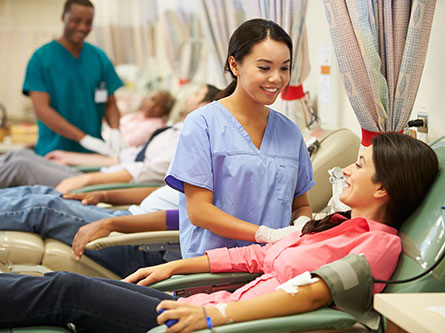Blood donations are always needed, but the winter and summer months often bring a critical shortage.
In January 2024, the American Red Cross declared a national emergency due to the shortage of blood. They're seeing the lowest number of people giving blood in the last 20 years. There's been a 40% decrease in the number of people donating.
Below is some information to help you understand the impact your blood donation can make.
Why should you donate blood?
Every 2 seconds, someone needs a blood transfusion in the United States. A single blood donation can save the lives of up to three people.
Your donation is used during transfusions and procedures that help patients who have lost too much blood. Blood donations can also help people whose bodies can't create a normal amount of blood cells to keep them stable.
Blood donations are needed more during the winter months to help keep up the supply throughout the U.S. Holiday celebrations, poor weather, and increases in illnesses like the cold, flu and COVID-19 lead to reduced donations in the winter months.
The summer months can also lead to shortages. People are often too busy on vacation or enjoying the warm weather.
A lack of blood supply in hospitals can lead to an inability to care for sick or injured patients.
How do you donate blood and what is the procedure like?
The actual blood donation takes about 10-20 minutes. Your entire appointment lasts 45-60 minutes including paperwork, donation, and a 15-munute observation time.
When you're ready to donate, you can search online for "blood donations near me" and find a good spot to donate close to you. You can also use this tool to find locations near you.
Before your appointment, make sure you eat a good breakfast and drink lots of water the day before and the day of donation. Drinking water helps hydrate your body tissue, increases the volume of blood and makes it easier to find a vein to draw from. Proper nutrition and hydration can help you avoid feeling dizzy or lightheaded.
Once you arrive, you will answer some questions and fill out a form to get your medical history and basic personal information. When that's complete, you'll lie down in a chair while the nurse places a needle into your arm for the blood draw.
After about 10-20 minutes, your blood donation will be completed. Before leaving the facility, you will be asked to stick around for 15 minutes to enjoy free snacks and drinks. This is to ensure you don't have a negative reaction, like dizziness.
Make sure to drink plenty of fluids after the procedure while sticking to your normal meal schedule. You can donate up to six times a year. However, you'll need eight weeks between sessions for your body to recover what was lost.
What's the difference between donating blood and donating platelets?
Blood is most often given to patients with traumatic injuries, those with cancer, or those undergoing surgery. Platelets are tiny cells in your blood that form clots and stop bleeding. They're used when patients are bleeding or when their platelet level is critically low, to prevent bleeding such as with leukemia.
Every 15 seconds, someone needs platelets. They're essential to surviving and fighting cancer, chronic diseases, and traumatic injuries, according to the Red Cross.
The platelet donation procedure is a little different than a regular blood donation. Here are some of the differences:
- Platelets cannot be donated at a blood drive.
- Platelet donation uses a machine to extract just your platelets and returns the rest of your blood back to you.
- From start to finish, it takes about 3 hours to donate platelets.
- You may be able to donate platelets up to 24 times a year as compared to 6 times a year for regular blood donation.
Learn more about the differences between donating blood and platelets
Where can you donate?
An easy way to find a donation center is to search online for blood donations near you or in a certain city.
UC Davis Health partners with the American Red Cross to provide blood donation services across our facilities. Over 7,000 patients each year are given blood transfusions through UC Davis Transfusion Services.
To learn how and where to donate locally, call 1-800-RED-CROSS or check out the American Red Cross online. For other donation options, see where you can find your nearest blood donation center.




